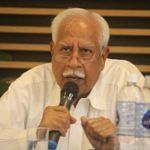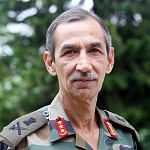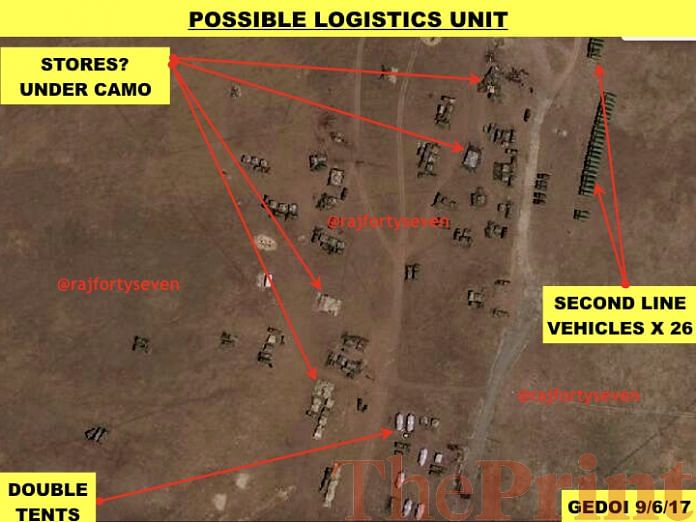Almost two months after India and China announced that they had peacefully resolved their bitter military face-off in the disputed Himalayan region of Doklam, exclusive satellite images accessed by ThePrint show that the People’s Liberation Army has amassed at least 2,000 troops armed with heavy and lethal equipment near the same area. ThePrint analysis of the images by its contributing editor Col. Vinayak Bhat (retd.), an Indian Army satellite intelligence veteran, indicates that the PLA brigade can return to the same Doklam flashpoint within two hours by vehicles.
Was the Doklam standoff resolved in reality or will tensions flare-up again? We ask experts.
China has kept its options for an escalation open
 Manu Pubby
Manu Pubby
Deputy Editor, ThePrint
There is no doubt that there isn’t a likelihood at the moment of a direct confrontation or contact between Indian and Chinese troops in Doklam. The tactical goal of the Indian Army to prevent the Chinese side from building a critical road up the plateau has been achieved with road building equipment being taken back from the contentious spot.
However, as recent satellite images accessed by ThePrint clearly show, the Chinese have not backed down to normal levels that existed in the area before the stand-off began in June. The presence of a Brigade-plus strength within striking distance of not only Doklam but other areas in Sikkim shows that China has kept its options for escalation open.
The unprecedented Chinese deployment – not in several decades has such forward deployment been carried out in the Chumbi valley – has been responded to with alacrity with counter moves forward but there are little options but to continue a watchful posture on the border.
To bring in a naval analogy, the situation is similar to the deployment of a very visible aircraft carrier in international waters close to a point of conflict. The carrier has all legal rights to be there, silent but watchful but its latent power lies in the threat perception it brings in.
The thing to watch out for is whether the troops stay on during the coming harsh winter or leave. That will bring clarity to how deep the resolution of the Doklam crisis is.
PLA aims to occupy areas which can be used for bargaining at a later date
 Col. Vinayak Bhat (Retd.)
Col. Vinayak Bhat (Retd.)
Former Military Intelligence officer, Indian Army
Here are some answers to questions that have been raised over the PLA deployment near Doklam. The road from deployment area to Yadong town is 7-8 m wide with 1-1.5 m berms on either side – in the areas opposite of North Sikkim. These roads are black-topped. The road beyond Yadong is also black-topped for some distance and then is made of compressed earth. These roads can take sustained traffic of motorised infantry and other support vehicles with ease.
The movement of a brigade will most certainly be staggered considering which side gets to achieve air superiority. But when hostilities are neither declared nor expected, it could move at full speed.
India, however, is confident that we can depend on its Army to take necessary action against adversaries.
Some people have called this fake news. The aim of this exclusive report was to put out facts based on an accurate analysis of satellite imagery, which cannot be faked.
We must understand the aim of such a deployment of PLA in this area. It certainly won’t be to attack any post of the Indian Army but it will be to occupy certain areas, which would be used for bargaining at a later date. This can put India in a very tight spot.
The disengagement has had repercussions inside China with clear indications that people are upset
 Jayadeva Ranade
Jayadeva Ranade
Former Additional Secretary in the Cabinet Secretariat, and President of the Centre for China Analysis and Strategy
As Indian and Chinese diplomats try to repair the relationship damaged by China’s unprecedented threats and vitriolic propaganda during the 73-day face-off on the Doklam plateau, it needs to be understood that on 28 August both agreed to disengage to defuse the situation. Both armies remain 300 metres apart in the area with reinforcements and additional firepower ready at hand.
Chinese Foreign Minister Wang Yi’s remarks, the only so far by a senior Chinese official, asserting that Doklam is Chinese territory and China shall build the road to Gyemochen underscores the situation is fragile.
There is also a disconnect with the People’s Liberation Army (PLA) and China’s powerful propaganda apparatus adopting attitudes different from China’s diplomats. PLA personnel exchanged no pleasantries with Indian counterparts on China’s National Day on 1 October and the annual ‘Hand-to-Hand’ exercises have not materialised. Stymied by the swift and unanticipated action of Indian forces stopping the road construction, the PLA is smarting at the decision to disengage. Seeing India stand its ground despite threats and vicious propaganda, Chinese President Xi Jinping probably concluded the PLA could not achieve a decisive victory against India. Heavy doses of ideology and nationalism ensured that anything less than decisive victory is a humiliation for China, the Chinese Communist Party (CCP) and Xi Jinping, especially before the 19th Party Congress.
The disengagement has had repercussions inside China with clear indications that people are upset. On 30 August, retired PLA Colonel Yue Gang commented that, “It was a humiliating defeat for China to cave in to pressure from India despite all the tough talk.” Serving PLA Major General Qiao Liang, publicly justified the withdrawal as “strategic positioning”, arguing that entering into “military conflict with India at this point of time would only harm China”.
India-China relations are currently uncertain. China’s political and military leadership will evaluate available options to salvage damaged pride and choose a time and place when they are better placed.
The question for New Delhi is: how can India cope with a long term shift in the strategic picture at the Bhutan tri-border point
 Ankit Panda
Ankit Panda
Senior Editor, The Diplomat
News that the Chinese People’s Liberation Army continues to maintain a sizeable presence in and near the Doklam plateau, near the India-China-Bhutan tri-border point, should only come as a surprise to those who read the late-August India-China “disengagement” as an end to the summertime stand-off.
In reality, the Doklam standoff never truly concluded. What India and China achieved in late-August, days before the BRICS Xiamen summit would place Prime Minister Narendra Modi and President Xi Jinping face-to-face, was an important reduction in temperature—a result of much diplomatic legwork on the Indian side especially.
Troops on both sides retreated their positions, but did not withdraw. In fact, neither government used the word “withdrawal” to describe the late-August breakthrough. Indian observers correctly celebrated the disengagement and many even noted a tactical victory in the short-term: the very road that the PLA desired to extend at Doklam was never extended. Ergo, in one view, India had “won” at Doklam—at least, in the narrow, tactical sense.
However, as ThePrint’s imagery makes clear, the Doklam standoff, once it began to draw out, turned out to be about far more than just a road. China, presumably taken aback by the Indian Army’s resolve in responding to the attempted construction, has buttressed its presence in and near Doklam considerably. What’s more, this is likely to be a long-term state of affairs in that sector of the India-China border. Beijing’s buttressed position in the Chumbi Valley especially, extending south to the international China-Bhutan boundary at Sinche La pass, will alter the qualitative and quantitative balance of power in this sector than what it had been prior to the breakout of the Dolam standoff.
For now, the question on policymaker agendas in New Delhi should be how India can cope with a long term shift in the strategic picture at the Bhutan tri-border point. This standoff is far from over.
Such deployments on both sides do not change the status quo, but indicate that tensions subsist and may escalate again
 Constantino Xavier
Constantino Xavier
Fellow, Carnegie India
While the brigade-strength Chinese build-up near Doklam does not constitute an immediate threat of escalation, it does reflect that the issue remains unresolved and that Beijing is ready to explore all options to regain an upper hand.
The recent agreement ending the stand-off did not lead to a complete withdrawal of troops even on the Doklam plateau itself. It is therefore natural that the PLA has strengthened supply lines and raised troop levels in surrounding areas, of which the deployment depicted in the satellite pictures seems to be an example. In fact, India has done the same on its side of the border in recent weeks.
However, while such deployments on both sides do not change the status quo, they indicate that tensions subsist and may escalate again. China is ready to explore all options to correct what it perceived as a tactical defeat in August.
More than seeking to protect its reputation at home, Xi Jinping may be worried about the international signals the withdrawal has sent across Asia, as several countries informally supported India’s position and lauded its strategic acumen on the ground and its diplomacy to defuse tensions. Whether in Bhutan or elsewhere along the Line of Actual Control, Beijing may be tempted to reignite a micro-conflict in order to regain an upper hand and claim the victory it was searching for in Doklam.
It is also unclear whether India and Bhutan have agreed on a long-term plan and procedures in case of a new Chinese incursion. The Foreign Secretary’s recent visit to Thimphu may have served to discuss this, and also for New Delhi to convey that beyond strategic silence, Bhutan should also start developing its own border patrolling capabilities with Indian military assistance.
India now should be prepared to deal with the consequences of its decision to dare the dragon
 Harsh V. Pant
Harsh V. Pant
Distinguished Fellow, Observer Research Foundation, Professor of International Relations, King’s College London
Troop presence at Doklam should not be surprising and no serious observer of Sino-Indian relations would have suggested that the Doklam disengagement plan that led to the easing of Sino-Indian tensions in August was the end of the trouble.
The aim then was to de-escalate a potentially explosive situation. New Delhi’s handling of the crisis was responsible and mature as it refused to be drawn into escalation by Beijing’s bellicose rhetoric and did not lose its nerve. The upcoming BRICS summit and the Chinese Communist Party Congress played an important role in Chinese decision-making. The Doklam disengagement plan was defined in rather narrow terms so that both sides could save face.
Prime Minister Narendra Modi and Chinese President Xi Jinping signalled they are trying to move away from the bitterness engendered by Doklam by managing to put up a united front at the BRICS summit. They agreed that Doklam-like situations should not be allowed to recur, and charting out new mechanisms to strengthen the border defence agreements that have held in the past. They have identified the need to have closer communication between defence and security personnel of the two countries.
But Chinese forces remained in Doklam and patrolling continued just as before the crisis.
If there is evidence of growing Chinese military presence in Doklam today, then may be China has recognised the need to expand its military position at Doklam, given India’s tactical superiority there. Indian strategic planners should have expected this and one hopes that India too is buttressing up its military profile in the plateau.
In the Doklam stand-off New Delhi managed to send a message to China that India can dig in its heels if it feels its strategic interests are at stake. But international relations cannot be primarily viewed through the prism of ‘winning’ and ‘losing’. India now should be prepared to deal with the consequences of its decision to dare the dragon.
The weather, hereon, will not permit any kind of adventurism in these high altitude areas
 Lt Gen D.S. Hooda (retd.)
Lt Gen D.S. Hooda (retd.)
Former General Officer Commanding-in-Chief of the Indian army’s Northern Command.
Doklam was one incident in a series of standoffs that have occurred in the past few years along the Line of Actual Control with China. It was protracted but has clearly been resolved. It is well known that additional soldiers were brought into this area by both sides, and from satellite images, as reported by ThePrint, some of these PLA units are still deployed in the Chumbi Valley. This is not really a cause of concern.
The weather, hereon, will not permit any kind of adventurism in these high altitude areas. The Indian Army is in a very advantageous tactical position in this sector because it occupies most of the heights along the watershed and can dominate any local action by the PLA. Anything more than a local action will require a major induction of troops.
In my view, we have heard the last of Doklam, at least for the next six months until the weather improves.
Will tensions flare up again? Most certainly they will because there is an inevitability to the fact that two strong neighbouring powers will inevitably jockey for supremacy. Strategic differences between India and China have been out in the open for some time and the resultant tensions will manifest along the unsettled border.
Doklam was different from previous standoffs because of an intense media campaign run by the Chinese. In some ways this has backfired and the PLA would be smarting. In my view, tensions along the border will be the reality for the next few years. Infrastructure development along our northern borders needs a big push.
It is necessary to ascertain whether there has been a build up after 28 August
 Lt Gen S.L. Narasimhan (retd.)
Lt Gen S.L. Narasimhan (retd.)
Distinguished Fellow, Centre for Airpower Studies
Even though the disengagement of troops from India and China took place on 28 August at Doklam, it still occupies mind space of the Indian audience. There have been reports of troops being amassed by the Chinese in the Chumbi Valley. The present report is based on satellite imagery of 6 September.
One is not sure if that deployment still persists. It is also necessary to ascertain whether there has been a build up after 28 August. The area depicted is the area West of Chomolhari Peak which is closer to the area of Phari Dzong. That is a traditional exercise area for PLA from June to September every year. Therefore, it is likely that the brigade which moved in for exercises stayed on until the Doklam issue got resolved. Even after an incident gets resolved, it is a normal practice for troops from either side to stay in that area to ensure that nothing goes wrong. The deployment shown in the imageries is the way any army unit would deploy during exercises and operations.
Though there are indications that tanks are in that area, which is a normal phenomenon when PLA exercises there, their employment will be very restricted due to the terrain in Doklam. Ever since the PLA started undergoing reforms in November 2015, all exercises have been in combined brigades. This is to improve their joint operations capability.
The areas in North Sikkim are held by Indian forces throughout the year. Therefore, any occupation of that area is not possible without a contest.
Keeping these in view, I tend to agree with the government sources that there is nothing to be alarmed about but that area needs to be constantly kept monitored. On the question of whether tensions will flare up again, it is unlikely in the near future.
(Views expressed are personal)
In the absence of positive re-engagement, any troop build-up around Doklam will be seen as escalatory
 Pranab Dhal Samanta
Pranab Dhal Samanta
Editor, ThePrint
The resolution to the Doklam stand-off had two facets: one, troop disengagement plus withdrawal; and two, re-engagement through dialogue to avoid such a situation in the future.
While the first part did happen on 28 August, it’s the second part which has failed to kickstart despite positive indications from the meeting between Prime Minister Narendra Modi and Chinese President Xi-Jinping at Xiamen soon after troops moved out of the face-off site.
In the absence of positive re-engagement, any troop build-up around Doklam will be seen as escalatory. Rather than being dismissive just because there’s no immediate stand-off to deal with, the government needs to take a harder look at the context.
The year is about to end and the annual India-China military exercise is yet to be held. It was China’s turn to host the event this year, but Beijing has not indicated any dates so far.
The annual bilateral meeting between Defence Ministry officials of both sides to firm up the schedule of military-to-military interaction for the next year has still not taken place. The DGMO hotline between both the military headquarters, a measure agreed to during Modi’s 2015 visit to China, is yet to be implemented.
In any case, there’s very little that happens in defence between the two countries. So, when even that comes to a halt, a gradual re-deployment of troops within months of a stand-off having ended will certainly raise suspicions.
It’s imperative that in the political euphoria of having creditably managed to end the Doklam stand-off through dialogue, the government must not lull itself to complacency.
These images must, in the immediate analysis, be seen as warning signs that underline the need to explore further conversation at the earliest, if the situation is to be guided to a longer period of normalcy.




All satellite imageries have the coordinates of the image. the absence of any such data in the imagery posted makes the thrudt of the story irrelevant since the imagery could be anywhere- at a PLA base well inside China, in the area inside the disputed Bhutan-China territory, near the Bhutan boundary but in the Chinese side of the disputed terriroty etc. Inshort in the absence of such hard info on the geographic coordinates of the imagery makes the stroy irrelevant. It could be anywhere- one could as well show an imagery of the Indian troops anywhere in Sikkim and claim that Indian troops are amassing the Doklam area.
Either such coordinates data was available and ThePrint chose not to show it, in which case somke justification for such an omission is in order or The Print does not have any such coordiante information which indicates a lack of professionalism on the part of whoever wrote the story